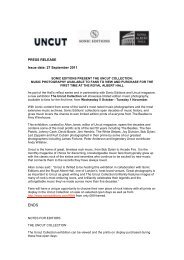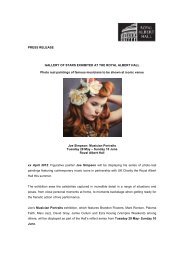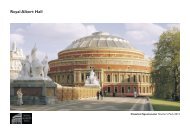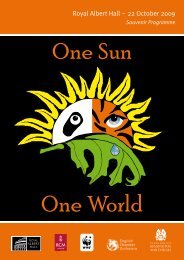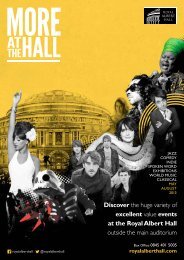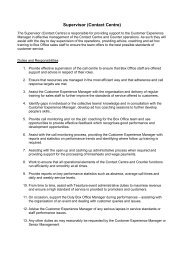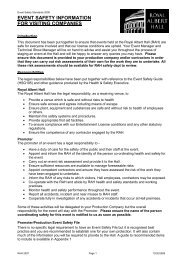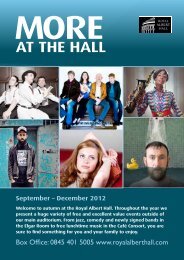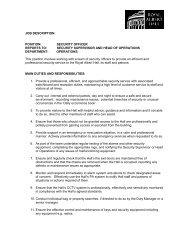THE ViCToRiANS - Royal Albert Hall
THE ViCToRiANS - Royal Albert Hall
THE ViCToRiANS - Royal Albert Hall
You also want an ePaper? Increase the reach of your titles
YUMPU automatically turns print PDFs into web optimized ePapers that Google loves.
<strong>Royal</strong> <strong>Albert</strong> <strong>Hall</strong> Education<br />
<strong>Royal</strong> <strong>Albert</strong> <strong>Hall</strong><br />
Kensington Gore<br />
London<br />
SW7 2AP<br />
Tel: 0207 589 3203<br />
education@royalalberthall.com<br />
www.royalalberthall.com<br />
Registered Charity No: 254543<br />
Design: www.thiswayupdesign.co.uk<br />
<strong>THE</strong> <strong>ViCToRiANS</strong><br />
EDUCATioNAL ACTiViTY PACK<br />
Name: Age:<br />
Generously supported by the Band Trust
The <strong>Royal</strong> <strong>Albert</strong> <strong>Hall</strong><br />
The <strong>Royal</strong> <strong>Albert</strong> <strong>Hall</strong> was the idea of Prince <strong>Albert</strong>, Queen Victoria’s<br />
husband. <strong>Albert</strong> was Victoria’s cousin and had moved from his home in<br />
Germany to marry her when he was only 21 years old. <strong>Albert</strong> wanted<br />
to create a <strong>Hall</strong> where music concerts could be performed and the<br />
Arts and Sciences could be explored and celebrated.<br />
<strong>Albert</strong> worked hard planning and organising The Great Exhibition to<br />
encourage trade and progress in manufacturing techniques. Because of his<br />
hard work, the Exhibition was very popular. The Exhibition made a profit,<br />
which was spent developing the Art and Science institutions in South<br />
Kensington, including the <strong>Royal</strong> <strong>Albert</strong> <strong>Hall</strong>. However, <strong>Albert</strong> died before<br />
the <strong>Hall</strong> was opened and so Queen Victoria decided it should still be<br />
built and named after <strong>Albert</strong> as a memorial.<br />
Task1<br />
Victorian Timeline<br />
The timeline of the <strong>Hall</strong>’s history has become muddled. Can you draw a line<br />
from each event to the correct point on the timeline provided?<br />
862<br />
First underground<br />
opens in London<br />
87<br />
Queen Victoria opens<br />
the <strong>Royal</strong> <strong>Albert</strong> <strong>Hall</strong><br />
837<br />
Victoria becomes<br />
Queen<br />
90<br />
Queen Victoria dies<br />
876<br />
Alexander Bell invents<br />
the telephone<br />
85<br />
Great Exhibition held in the<br />
Crystal Palace in Hyde Park<br />
86<br />
Prince <strong>Albert</strong> dies<br />
1830 1840 1850 1860 1870 1880 1890 1900 1910<br />
870<br />
Law passed which rules all<br />
children between the ages of<br />
5 – 10 must attend school
Mini Task<br />
Mix and match<br />
See if you can match the following pictures of the <strong>Hall</strong> with their descriptions.<br />
Close up of the frieze<br />
<strong>Albert</strong>’s initials on the outside<br />
of the building!<br />
<strong>Albert</strong>’s initials on every railing!<br />
Close up of the pipe organ<br />
inside the auditorium<br />
A section of the frieze and the sky!<br />
The frieze from afar<br />
View from the roof<br />
Queen Victoria<br />
Queen Victoria is the longest reigning British monarch. She was<br />
crowned when she was only 18 years old and was on the throne<br />
for 64 years, from 1837-1901. Queen Victoria was dutiful and hard<br />
working, taking her roles as Queen, mother and wife very seriously.<br />
Because of this, she was respected by the people she ruled.<br />
Queen Victoria had nine children and she was the first Queen<br />
to move into Buckingham Palace. During her reign, she greatly<br />
supported changes to improve the lives of the Poor. The Queen<br />
and her husband, Prince <strong>Albert</strong>, also supported many charities<br />
involved in education and public health. Queen Victoria out-lived<br />
<strong>Albert</strong> by 40 years and survived seven assassination attempts<br />
between 1840 and 1882.<br />
Task 2<br />
Key words<br />
After reading the biographies and<br />
looking at the pictures, which words<br />
would you use to describe the<br />
characters of Queen Victoria and<br />
Prince <strong>Albert</strong>? See if you can think<br />
of 5 words to describe each of them.<br />
Prince <strong>Albert</strong><br />
At first, the Victorian public did not like Prince <strong>Albert</strong> and he was<br />
never given a proper title or any position of political power. it wasn’t<br />
until 17 years after he married Queen Victoria that he was named<br />
Prince Consort. Prince <strong>Albert</strong> was a great influence on his wife and<br />
was her personal secretary for many years. He was well educated,<br />
had a great interest in the Arts and Sciences, and enjoyed designing<br />
things including a Snooker table which he had built for his house.<br />
He was a talented businessman, successfully tripling the profits of<br />
the <strong>Royal</strong> estates. Prince <strong>Albert</strong> died after contracting Typhoid at<br />
the age of 42, sadly before he had a chance to see the completed<br />
<strong>Royal</strong> <strong>Albert</strong> <strong>Hall</strong>.<br />
1.<br />
2.<br />
3.<br />
4.<br />
5.<br />
Queen Victoria Prince <strong>Albert</strong><br />
2 3
Task 3<br />
The Victorian Times<br />
Imagine you are a reporter for the Victorian Times newspaper and write an article describing the<br />
events of the opening ceremony. Look at the four pictures. Think carefully about what they can tell<br />
you about the day and use them as inspiration for your article. You can then draw one of the<br />
pictures into the box provided.<br />
interior of the <strong>Hall</strong> at the opening ceremony<br />
Queen Victoria arriving at the <strong>Hall</strong><br />
for the opening ceremony<br />
Poster for the opening ceremony<br />
Exterior of the <strong>Hall</strong> at the opening ceremony<br />
5
Billy’s story – how the Poor experienced the <strong>Hall</strong><br />
As well as the Lords and Ladies who attended the opening of the <strong>Royal</strong> <strong>Albert</strong> <strong>Hall</strong>, many ordinary<br />
members of the public came to get a glimpse of Queen Victoria at the launch of the building that<br />
honoured her late husband.<br />
Billy is ten and comes from a very poor family. As a special treat he is being allowed a day off school<br />
and is going with his grandfather to see the opening of a large grand concert hall – the <strong>Royal</strong> <strong>Albert</strong> <strong>Hall</strong>.<br />
Billy has dressed in his best clothes; a pair of trousers, with patches to cover up the holes, a shabby<br />
waistcoat and a cap. His mother has given him a packed lunch of bread and some cheese and Billy and<br />
his grandfather are travelling on the new underground trains. When they get to the <strong>Royal</strong> <strong>Albert</strong> <strong>Hall</strong>, they<br />
go in through one of the smaller doors and then climb up five flights of narrow stairs to get to their seats in<br />
the Gallery, right at the top. In the Gallery there are 2,000 people who are poor like Billy and have saved<br />
up to buy a ticket to see the opening. Tickets up in the Gallery cost £1 and 1 shilling, which is a whole<br />
week’s wages for Billy’s dad. It is very crowded and quite smelly. However, Billy does not notice as he is<br />
so excited to be seeing the Queen who will be entering the Queen’s box at any moment.<br />
Task 4<br />
Diary entry<br />
Above is Billy’s story. He was a young boy lucky enough to come to the opening ceremony at the<br />
<strong>Hall</strong> after his parents saved up to buy him a ticket. Read through it and then write a diary entry in<br />
the space provided below. imagine that you are Billy. Describe how Billy is feeling when he comes<br />
to the <strong>Hall</strong> and what sights and sounds he experiences.<br />
Task 5<br />
Rich vs Poor<br />
Rich<br />
Both<br />
Poor<br />
on the diagram above, record the ways in which a visit to the <strong>Royal</strong> <strong>Albert</strong> <strong>Hall</strong> would<br />
have been similar and different for poor and rich people.<br />
Look back at the work you did on pages 5 and 6 which records the visits of both Queen<br />
Victoria and Billy. Use those pages and any other knowledge you have about rich and poor<br />
Victorians to help you complete the task.<br />
For example, you could compare the ways in which they would have travelled to the <strong>Hall</strong>,<br />
where they would have sat, what they would have worn, who they would have met and<br />
what would have saddened or excited them.<br />
6 7
Victorian Clothes<br />
For wealthy ladies to wear the fashionable dresses, they had to wear a corset<br />
underneath to make their waists very small. Corsets were sometimes made of steel and<br />
would squash their ribs, making it difficult to breathe. it was considered rude for ladies<br />
to show their ankles and so they would wear very long skirts. For some of the Victorian<br />
Age, fashionable ladies wore crinoline skirts which were huge, bellshaped<br />
skirts worn over hoops of steel and whalebone, making it<br />
difficult to get through doors or up narrow stairways. However, by<br />
the time the <strong>Royal</strong> <strong>Albert</strong> <strong>Hall</strong> opened in 1871, the crinoline was<br />
out and the ‘bustle’ was in fashion. Skirts were now swept up at the<br />
back into a padded cushion called a ‘bustle’. Ladies could not wash<br />
their hair very often so bonnets became an important fashion item.<br />
A bonnet is a type of hat. Lace, ribbons and even real bird feathers<br />
were used to decorate them.<br />
Like modern men, Victorian men who could afford it would wear a<br />
jacket, waistcoat and trousers, but they were not made from matching<br />
cloth. Men would always wear a waistcoat and if they were going<br />
somewhere in the evening, the waistcoat might be made of silk, satin<br />
or velvet. They would also wear a cravat around the neck which was similar to the ties<br />
worn today. Victorian men would wear long woollen underwear and sometimes they too<br />
would wear a corset to keep their stomachs in! When they left the house, wealthy men<br />
would always wear a top hat, gloves and would often carry a walking cane.<br />
There were not special clothes for children; boys and girls would be dressed like their<br />
parents and it was not easy for them to run and play wearing these sorts of clothes.<br />
often boys would be put in dresses until they were aged four or five. When they were<br />
at school, children would wear pinafores over their clothes to stop them getting dirty.<br />
Task 6<br />
Rhyming poem<br />
Read through the text on page 8 which is all about Victorian<br />
clothes. Write a short rhyming poem in the space below, using<br />
four of the words written in bold.<br />
8 9
0<br />
Task 7<br />
Design your own programme<br />
imagine that you are staging an event at the <strong>Royal</strong> <strong>Albert</strong> <strong>Hall</strong>. it can be anything you like: it could<br />
be the <strong>Hall</strong>’s first ever football match, or a concert by your favourite pop singer, or maybe your school<br />
is doing a special performance.<br />
Have a look at some of the programme covers for previous shows below. in the space provided,<br />
design the cover for the show you have decided to stage at the <strong>Hall</strong>.
Task 8<br />
The <strong>Royal</strong> <strong>Albert</strong> <strong>Hall</strong> is for sale!<br />
imagine you are an Estate Agent and it’s your job to sell the <strong>Royal</strong> <strong>Albert</strong> <strong>Hall</strong>. Create a set of<br />
details that will help sell the building to someone who has never been to the <strong>Royal</strong> <strong>Albert</strong> <strong>Hall</strong>.<br />
include the following:<br />
Strap-line:<br />
This is the first line that any interested buyer will read. it should be a way of grabbing their attention,<br />
making them want to read on…just like the headline in a newspaper.<br />
Introduction:<br />
Using the space below, make a list of the best features of the <strong>Hall</strong> and a list of words that<br />
describes those features.<br />
Using your list, create a paragraph that tells the buyer about the building.<br />
Remember that you want your reader to buy the <strong>Hall</strong>, so focus on the things you think are<br />
the most special.<br />
Here are some examples to help you get started:<br />
Boxes – Intimate, Cosy, Unique<br />
Pipe Organ – Largest in the UK, Golden<br />
Auditorium – Red, Vast, Impressive, 5,200 seats<br />
2 3
<strong>Royal</strong> <strong>Albert</strong> <strong>Hall</strong> Quiz<br />
1. Whose idea was it to build the <strong>Royal</strong> <strong>Albert</strong> <strong>Hall</strong>?<br />
2. Why was it named the <strong>Royal</strong> <strong>Albert</strong> <strong>Hall</strong>?<br />
3. On what date was the <strong>Royal</strong> <strong>Albert</strong> <strong>Hall</strong> opened?<br />
4. How did Queen Victoria arrive at the opening ceremony?<br />
5. Why did Queen Victoria wear black at the opening ceremony<br />
of the <strong>Royal</strong> <strong>Albert</strong> <strong>Hall</strong>?<br />
6. Who conducted the orchestra at the opening ceremony concert?<br />
7. Where are the cheapest seats in the <strong>Royal</strong> <strong>Albert</strong> <strong>Hall</strong>?<br />
8. Is the <strong>Royal</strong> <strong>Albert</strong> <strong>Hall</strong> pipe organ the largest or smallest in the UK?<br />
9. What shape is the auditorium?<br />
10. How many seats are there in the auditorium?<br />
You might need to have a look back through the work you have done<br />
in this book to help you answer some of the questions.<br />
Answers on page 16<br />
Word search<br />
ACOUSTICS<br />
GREAT EXHIBITION<br />
ALBERT<br />
KENSINGTON<br />
AUDITORIUM<br />
ORGAN<br />
BOX<br />
PROMS<br />
CONCERT<br />
ROYAL RETIRING ROOM<br />
CORSET<br />
STAGE<br />
DOME<br />
VICTORIA<br />
GALLERY<br />
5
6<br />
Quiz Answers<br />
1. Prince <strong>Albert</strong><br />
2. After Queen Victoria’s husband, Prince <strong>Albert</strong><br />
3. 29 March 1871<br />
4. Horse and carriage<br />
5. in mourning for Prince <strong>Albert</strong><br />
6. Sir Michael Costa<br />
7. Gallery<br />
8. Largest<br />
9. Elliptical or oval<br />
10. 5,222<br />
Acknowledgements:<br />
Photos:<br />
Michael Betts<br />
Sheila Burnett<br />
Chris Christodoulou<br />
Marcus Ginns<br />
In addition:<br />
Caroline Hillyard and the children of St Jude’s Primary School, Southwark<br />
Lara Agnew and the children of Alma Primary School, Southwark<br />
Rev Reji Raj-Singh and the children of St James’ & St Michael’s Primary School, City of Westminster<br />
Miranda Clarke<br />
On behalf of the <strong>Royal</strong> <strong>Albert</strong> <strong>Hall</strong>:<br />
Jacky Cowdrey<br />
Matt Warburton<br />
This pack was written and edited by:<br />
Lorna Flynn<br />
Ros Templeman<br />
Rachel Farrell<br />
These tours are generously supported by the Band Trust.




